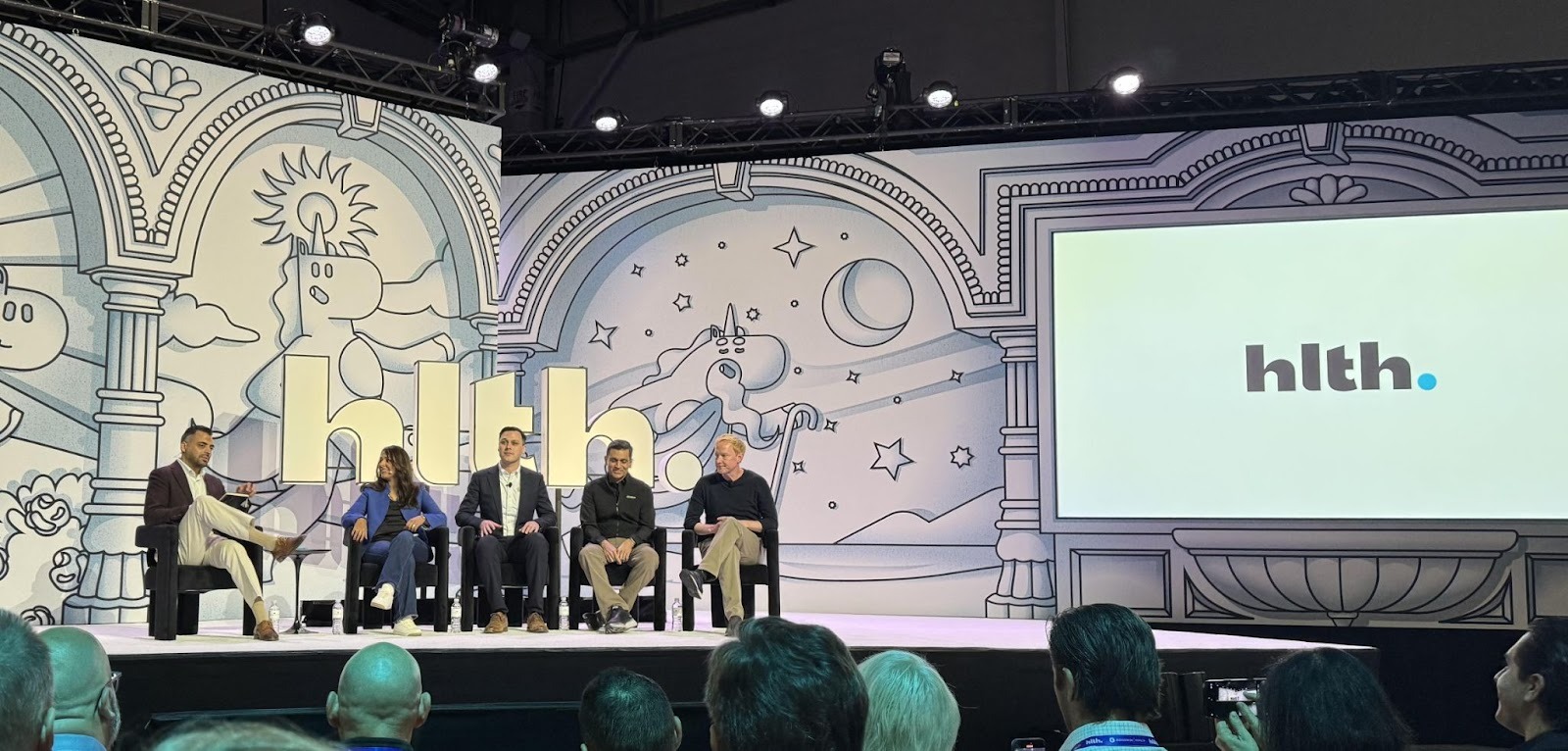Consider reading these articles

At HLTH 2025, AI was the baseline for most conversations, not just a buzzword. Enthusiasm was driven by agentic systems starting to scale, tangible ROI, and rising ambition. Still, the path to full system-wide impact remains a work in progress. Here are a few takeaways we brought back from Las Vegas.
1. A Packed but Exciting Innovation Landscape
AI agents will take your call now, and there are a lot of them:
In the weeks leading up to HLTH, voice AI startups like Assort Health, Prosper AI, Attuned Intelligence, and Hello Patient announced major raises, culminating with Hyro’s fundraise announcement as HLTH’s third day started on Tuesday. These companies are automating everything from health system call centers to front-office coordinators in primary care clinics. There was a plurality of voice AI startups at HLTH showcasing their early outcomes of 50-90% reduction in staff time spent on calls. Still, differentiation was sometimes hard to distinguish, and the race now seems more about customer acquisition speed than technological edge.
Foundational AI players are building AI healthcare applications, not just infrastructure:
Cleveland Clinic highlighted their partnership with Palantir to build risk stratification and triage algorithms, Google talked about an AI nurse handoff tool they built for HCA, and Microsoft spotlighted everything its Dragon Copilot can do for health systems. The largest technology players aren’t content to be just the infrastructure providers and are increasingly developing end-user solutions across the healthcare ecosystem. The approach foundational model providers themselves are taking to solution development remains to be seen. For example, OpenAI’s head of healthcare Dr. Nate Gross noted during a heavy hitting AI panel that healthcare AI isn’t going to be winner-take-all, with OpenAI preferring to partner with category leaders rather than compete head-on. This entry of tech giants into the application layer introduces new competitive dynamics that every AI startup must consider.

Agentic Giants panelists Aashima Gupta, Global Director of Healthcare at Google Cloud, Dr. Nate Gross, Head of Health at OpenAI, Raghav Mani, Director of Digital Health at NVIDIA, and Dr. Dominic King VP of Health at Microsoft AI discussing how their organizations are building in healthcare.
Patients are open to virtual and AI-enabled care when it’s faster and more attentive:
Patients are showing strong willingness to engage with virtual nurses and AI chat interfaces when those experiences are more immediate and attentive than traditional in-person interactions. HelloCare’s pavilion gave us a glimpse into how their solution drives high patient satisfaction by providing an on-demand, fully focused “nurse” who isn’t juggling multiple competing priorities. Access and attentiveness are things that AI can provide in spades, and this proxy is a good signal for the extent they’d be willing to interact with AI clinical interfaces in the future.
Exciting time for clinical AI development:
While administrative AI stole many headlines, clinical AI companies brought the hardware. The HLTH floor was filled with new sensors, scanners, test kits, and diagnostic tools, including voice biomarkers for cognitive health, at-home blood testing, and image-based lesion diagnostics. FDA approval and proprietary devices may prove one of healthcare AI’s most defensible moats, and it was energizing to see early-stage teams leaning into these regulated frontiers.
2. The Same Old Healthcare Problems, Now with More Data
We’re surfacing more data than ever but still can’t always act on it:
Ambient scribes are all advancing to proactively surfacing next steps in care in visit to clinicians while OpenEvidence’s is transcribing visits to preemptively show clinicians evidence based care recommendations. These examples taken together with the proliferation of risk stratification and identification algorithms across care delivery settings show that we’ve never had more readily available insight on how to improve care. The challenge remains execution, as providers still lack the time and resources to act on newly surfaced insights. Automation helps, such as auto-triggering orders, but deploying the longitudinal patient engagement resources to take action are often reserved for high-value cohorts with clear ROI. Without reimagining care delivery models for an AI-first world, more surfaced data alone won’t have the full potential impact.

Panelists Elad Walach, CEO of Aidoc, Jill Kalman, CMO of Northwell Health, Jenn Hall, Chief of Data Science and Analytics at the American Heart Association, and Nassib Chamoun, Founder and CEO of Health Data Analytics Institute talking about how to surface health information and act on it.
Healthcare incentives still aren’t aligned to address root healthcare problems:
AI continues to spark optimism about what’s possible in healthcare transformation, but the structural issues holding it back remain intact. Value-based care companies told us they’re facing heightened economic and regulatory headwinds heading into 2026, and fee-for-service incentives still dictate care models and priorities. Until we resolve misaligned payer and provider dynamics, AI’s potential to reshape high cost conditions through chronic disease management and long-term engagement will remain limited.
Designing solutions for liberated consumers will drive new healthcare paradigms at scale:
Momentum around patient-centric payment models like ICHRA and “portable benefits” platforms such as Stride Health was palpable. Challenges employers face when shifting to an ICHRA model like sticking employees with marketplace plans with higher deductibles and narrower networks, are being better understood and ameliorated. Employers are now also starting to see the potential flexibility ICHRA provides them to rebuild benefits around high-touch care models. Oscar and Hy-Vee partnered to offer employees on their ICHRA plans direct primary care that’s typically been inaccessible to employees and is proven to drive better PCP engagement. A hopeful example of what is possible as consumers continue to be a catalyst for change when given the chance.
3. Continued Spotlight on Managing GLP-1s
Positive signals, but still unproven ROI for complementary GLP-1 interventions:
Redesign Health’s Head of Strategy and Finance, Samantha Lynch, moderated Movement KPIs: Measuring the Impact of Movement as Medicine, where leaders from WellHub, Betterfly, Future, and PwC explored how employers are thinking about movement as a complement to and/or a preemptive intervention for GLP-1s. The discussion centered on “movement as behavioral infrastructure,” with AI-driven personalization and consistency emerging as the new metrics for engagement and outcomes. PwC’s new “consistency index” to compare wellness offering engagement across employees while platforms like Future and Betterfly show how data and gamification can make the business case for sustained participation via improved retention. As movement and medication increasingly converge, there still isn’t proven ROI for these new interventions and remains one of the biggest open opportunities for a breakthrough in this rapidly expanding space.
4. Large Organization AI Transformations are Here, Not Next
From experiments to permanence, leading organizations have infused AI into every workflow:
Pharma is setting the pace for organizational AI adoption at scale in healthcare. Amgen and BMS have made foundational models freely available to employees, paired with organization-wide training and help with building custom bots for everyone from scientists to executives. Their example highlights that AI nativity isn’t a future goal; it’s the current standard for leading organizations and is a great example for every vertical of healthcare as they adopt AI tools.
Agents continue to improve in their ability to automate complex and high leverage workflows:
Beyond general assistance AI tools, we heard several examples of how agents designed for distinct, high value functions are driving significant business outcomes. Medable created a CRA agentic system that they claim can handle 90% of a CRA’s clinical trial administrative tasks autonomously. BMS CTO Greg Meyers described how their AI tools analyzed tens of thousands of manufacturing batches for a highly complex drug and optimized the factors that drive yield that when implemented improved usable drug production per batch by 40%. Pharma may have clearer scientific endpoints for decision making compared to other areas of healthcare, but these agentic solutions demonstrate what’s possible when AI drives core business processes rather than just supporting them.

HLTH’s “AI Zone” had double the number of participating companies compared to last year and saw several big pharma names exhibiting.
5. AI's Impact on Health Systems Today and Overcoming The Pilot Challenge
Where healthcare delivery organizations are seeing real traction with AI:
Health systems at HLTH reported tangible ROI in several AI use cases, including clinical documentation, prior authorization, revenue cycle management, and administrative call handling. Utilization management is emerging as a near-term win, while care planning, staffing optimization, and true clinical triage are still developing but expected within five years. Notably, there was some consensus that the first AI doctor we’ll see will still be a radiologist.
Why many agentic deployments get stuck in pilot:
Scaling new agentic solutions has been one of the larger challenges across healthcare. Second to the number of voice AI companies at HLTH were a slew of companies looking to help build the infrastructure for agent development / deployment, including large incumbents like IBM. However, panelists and healthcare leaders alike agree that the issue isn’t just technical infrastructure. Agentic deployments need to:
- Have defined KPIs and goals at the start of any engagement
- Have the right technical and process monitoring in place for those KPIs to run quick feedback / improvement loops
- Formally involve stakeholders from every team from nursing to IT as they get rolled out,
- Change the workflow instead of bolting tech onto an existing process
6. Some of Our Favorite Phrases from HLTH
- “Momentum is the moat.” (especially in crowded AI spaces)
- “We’re probably still building faster horses at the moment, but faster horses make money.”
- “There’s a sizable difference between what AI models can do and what we use them for.”
- “We’re a big organization and we know we need help from partners to launch new AI solutions at speed.”
Conclusion: Turning Momentum Into Meaningful Change
HLTH 2025 showcased a sector buzzing with energy and experimentation, from clinical AI breakthroughs to organizational reinvention. Yet, the conference also reinforced familiar themes including healthcare’s structural inertia, uneven incentive alignment, and the growing divide between technological potential and system readiness.
At Redesign Health, we view this as both challenge and opportunity. The next generation of category leaders will be those who translate AI’s momentum into measurable outcomes, whether by empowering consumers, transforming workflows, or re-architecting care delivery itself. We’re excited to keep partnering with founders and organizations shaping that future.
If you’re interested in collaborating, reach out to buildwithus@redesignhealth.com
DATA INSIGHTS

Return to insights

.webp)
.png)

.png)
